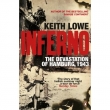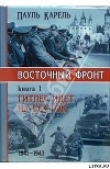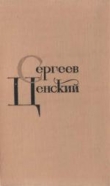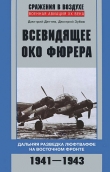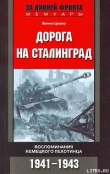
Текст книги "Rommel's Deutsches Afrika Korps 1941-1943"
Автор книги: Автор Неизвестен
Жанры:
История
,сообщить о нарушении
Текущая страница: 5 (всего у книги 19 страниц)
Fighting flared or sank until 26 April, with the German and Italian troops maintaining their positions but on short commons because their ration truck convoys were intercepted and destroyed by British armoured car patrols. On 24 April the 15th Panzer Division decided that its forces were strong enough to strike for Halfaya and, aware that the British tankmen frequently mistook the Volkswagen cars for Panzer I, bluffed their opponents as to the actual number of armoured fighting vehicles which were under command.
Rommel had been informed of the forthcoming attack and, anticipating victory, had already issued orders that elements from 15th Panzer would be withdrawn to the Tobruk front once Halfaya Pass was safely in German hands. The vehicles for the assault formed up ready to move forward but then came disaster as the Luftwaffe bombed its own troops and caused a postponement of the attack until 26th. To replace the losses and to strengthen the assault the positions held by German units north of Capuzzo and in Sollum were taken over by the Italians and Rommel's men were disposed on either side of the fort. At top speed the advance roared forward into the pass but was halted abruptly by extensive and sophisticated mine-fields. Against fanatical resistance the German point units dawed their way, until by nightfall they had captured the British trench line. Immediate and heavy thrusts by 8th Army's armour flung back the main body of 15th Panzer Division to Capuzzo leaving only infantry outposts to hold the Pass. During the night of 26/27th reinforcements from 3rd Reconnaissance Battalion, the Montemurro Battalion, and a German motor cycle company were sent up to thicken the line and the local commander now considered that he had sufficient strength to force the pass. The elements of 15th Panzer were returned to Tobruk to help in the assaults on that town, while a battle group struck again into Halfaya pass and overran the British defenders who withdrew south and east to the line Buk Buk-Sofafi. The pass had been captured and with the positions consolidated the motor cycle and the reconnaissance battalions returned to the Sollum sector and passed into reserve. The eastern flank was firm and a German enclave, although isolated from the main body of the panzer group and surrounded by British forces, was firmly in position along the Egyptian border. To the west of the outpost was the mass of the Axis forces investing a British enclave at Tobruk.
On 14 April Rommel had decided that he would assault Tobruk frontally with the forces at his disposal, hoping to catch the defenders not fully prepared. Against a garrison of unknown strength he could pit only 100 tanks, a machine gun battalion, an artillery battalion, an engineer company, and elements from Ariete Division, together with parts of an anti-tank battalion.
The plan was for the panzer regiment, with the men of the machine gun battalion riding into battle on the outside of the vehicles, to penetrate the outer line of defences during the hours of darkness and then to press on into the heart of the fortress, towards the objective, Point 187, a place some 4 miles west of the El Adem-Tobruk road where the ground suited a tank attack. The positions from which the attack would begin were held by the Ariete who had been on that sector since 12 April. Before the armour advanced the Engineer Company was to blow a gap in the wire, the panzers would pass through this and Ariete would seize the strong points on either side of the gap. The attack would go in under artillery fire and bombing attacks by Stuka aircraft. The whole operation was to begin at 04.00hrs on 14th – a delay of 10 hours from the original zero hour – to allow the panzer regiment's men time to rest after the long approach march from Mechili.
There was no time for discussion of the plan nor for adequate reconnaissance and thus the units were attacking in the dark and into an area with which they were unfamiliar. Improvisation was the order of the day and an engineer officer was given the task of hand-guiding the panzers through the gap in the wire. The noise and evidence of the preparations warned the Australians of 2/17th Battalion of the impending assault and, even as the attack opened, artillery covered the approach routes with a fierce and prolonged bombardment. The engineer officer lost his way and misdirected the tanks so that they were nearly 'bellied' in the anti-tank ditch before he found the gap and the penetration could begin.
But by this time dawn had broken, the German defensive fire plan had come to a halt, and a concentrated barrage of infantry and artillery fire was being directed upon the advancing panzers and their infantry. The armour advanced slowly thrusting through the crash of shell fire and the hail of machine gun bullets, vision reduced by the dust which the explosions and their own movement had raised, and gradually they penetrated the outer defence line. The advance suddenly halted. Immediately in front of the tanks lay the inner defence line based upon the Solaro and the Palastrino forts. The British fire rose to hurricane force driving the panzers back through the gap in the wire. The infantry who had already jumped from the tanks to engage the British infantry had suffered severe losses and small groups began to move back to the start line only to find that the way was blocked by Australian troops who had driven back thp Italian Ariete. The Italians had been unable to take the strong points and British infantry had recaptured and now dominated the ground between the gap and the retreating Germans.
Bitter, and in some cases hand to hand, fighting took place as the German machine gunners tried to force their way back. A few isolated groups battled their way through to the start line where they came under more intense fire from British horse artillery batteries as well as from the uncaptured strong points on either side of the breach. The panzer column, too, suffered as it drew back through the gap in the wire.
By 10:00 hrs the attack had obviously failed but Rommel ordered the panzers to go back in again to rescue those machine gunners who were still holding out inside the perimeter wire. Bending to the pleas of the divisional commander he cancelled his order and admitted, thereby, that he had suffered his first setback in Africa, although he could assure himself that now he had a good idea of the strength of the fortress. This knowledge had been bought at a high price in men and armour for 5th Panzer Regiment's loss of 16 vehicles represented 20 per cent of its effective strength in medium machines and with the virtual destruction of three-quarters of the machine gun battalion the infantry strength of 5th Light Division had been reduced by nearly 50 per cent.
In view of this set-back the question was raised again whether it would not be better to withdraw the Axis forces back to Cyrenaica and certainly Gariboldi, the Commando Supremo, and the senior German sources tried to influence his decision but Rommel determined to hold his position and to renew the attack once his strength had been made up. Indeed he pressed for more Italian divisions to be brought up and to invest Tobruk so that he could withdraw his German units and use them offensively. Gariboldi sent forward the motorised division Trento which had landed in Tripoli only a short time before and promised other units, but retained Pavia and Bologna Divisions for use along the Cyrenaican frontier. All these Italian units were sent as separate detachments, that is to say they did not combine to form Italian Corps as one would have expected, but remained as individual units under Rommel's direct control.
By the middle of April Tobruk was completely surrounded. Brescia held the western front, Ariete the south-western line, the 5th Light was on the southern sector, and the Santa Maria was on the south-eastern sector. Manning the eastern line was the bulk of Trento Division with one battalion at Sollum. But the line around Tobruk was so thin that in many places it was nothing more than a series of posts from which to observe the garrison. Then, too, the Axis front line was so far distant from the British defensive positions that an attack could be brought under fire before it had shaken out into correct formation.
British attacks which came in after the middle of April against the Italian-held western and south-eastern sectors met with such a great measure of success that they produced crises. During one attack a whole battalion of 800 men was taken prisoner and on Trento sector the Italians gave up ground which enabled the British to enjoy first-class observation and to direct accurate and heavy artillery fire upon the Axis lines of communication. These British successes, although local in area and small in scale, demonstrated to the 8th Army the weakness of the Axis beleaguring forces and encouraged the garrison commander to increase the size of his assaults upon the weaker Italian units in the full and certain knowledge that these would almost certainly meet with success. Rommel's problems were lightened, however, on 23 April when a rifle battalion and an artillery battalion, both from 15th Panzer Division, reached Tobruk area and Rommel put them straight into the line to plug another hole which had been punched in the front of Brescia Division.
Back on the mainland of Europe there had been two differing reactions to the successes which Africa Corps had achieved. At public level there was admiration and even, perhaps, a little hope that, in place of the colonies which Germany had lost after the First World War, Rommel might carve out a new and bigger colonial Empire. At the sober and coldly intellectual level of the military high commands there was a completely different reaction. It must be understood that the German High Command, already burdened with details for the forthcoming attack upon Russia, had suddenly had off-loaded upon them a Balkan campaign to rescue Mussolini and the Italian Army. Now, on the African front, there was a general who, with limited resources, had achieved a certain measure of success but who might go on to demand more troops, tanks, and guns. Rommel had caught the public imagination and he had been Hitler's personal choice for the African command. If he were to go on to fresh victories then the drain upon Germany's manpower resources might lead to strength needed for the main Russian front being siphoned off to a side-show operation; a military cul-de-sac. In any case, Rommel had gone against the instructions of the OKH. He must be brought to heel.
Accordingly on 27 April, von Paulus, the representative from OKH arrived on a tour of inspection to assess the chances of Rommel conducting a successful defence of the Italian colonies, to discover his future intentions, and to advise him of how few were the manpower and material reserves in Germany. Impassively the trained staff man listened to the commander in the field and refused to countenance the future and strategic plans that Rommel had drawn up.
With the arrival of 15th Panzer Division units the critical manpower situation in front of Tobruk had eased slightly and Rommel had decided to reduce the fortress by mounting another attack. This would come in from the south-west, would pass through the Brescia Division, and thus from a direction completely unexpected by the British. The ground was suitable for panzer movements and a successful initial assault would gain observation points from which artillery fire could be directed during the subsequent phases of the battle. There were already large gaps in both the wire and the anti-tank ditches. May Day was the date set for the attack and by that time Rommel hoped to have gathered the strength necessary to fight a successful battle. To build up his forces without delay he requested OKH [6] to airlift the remaining infantry component of 15th Panzer Division.
The orders for the new offensive were that on the Sollum front there were to be demonstrations and movement to give the impression that the attack would come from the east. On the Tobruk front a mixed infantry, tank, and anti-tank group of 5th Light Division would assault and seize the south and southwestern faces of Ras el Mdauar during the night of 30 April and at dawn a panzer attack would continue eastwards towards Fort Pilastrino. The left flank neighbours, mainly an infantry group of 15th Panzer, would take out the strong points on the north of Ras el Mdauar and cut the ridge running eastwards from Acroma. At daybreak this group would advance on both sides of the Acroma track towards Pilastrino and attack towards Tobruk harbour.
One battalion of 115th Infantry Regiment was to send out storm troops to take the strong point along the combat sector and then launch a night attack which would carry them into the fortress. The actual assault group, a regiment made up of all the other divisional troops, would enter the captured areas during the night and at dawn would go through the positions won by the battalion to conduct the final assault. To soften up the defences before the attack began, artillery and Stuka bombardments would be carried out at last light and two Italian divisions, one on either side of the main infantry and panzer groups, would roll up the British line and take out strong points.
When these orders had finally been issued, Von Esebeck commanding 15th Panzer lodged an immediate protest against the time of the assault and against the plan of attack. His troops which had been brought by plane from the mainland would arrive tired and without their equipment and would have to take part in an attack unrested and hungry not knowing the terrain for Rommel, in overruling the protests, forbad any pre-battle reconnaissance.
The offensive opened on 30 April as planned with a heavy artillery barrage falling upon the breach area and at other points to confuse the Australian defenders of 26th Brigade as to the direction and point of assault. The first troops moved out followed by the machine gun battalion and 115th Regiment's Battalion and soon the first optimistic reports came in that many of the field defences had been captured according to plan. These reports proved to be untrue for the attacking troops, expecting European-style pill boxes standing above the ground, had not been told that the fortifications in Tobruk were sangar-type strong points at ground level and, therefore, had not captured them. The situation at midnight was so unclear that 15th Panzer Division's commander asked whether the assault regiment should take up position within the perimeter and, having received the confirming order, sent in the men at 02.00hrs. Immediately the regiment came under British fire. By first light the situation in the gapped area was still unresolved and remained so until 08-OOhrs when early morning fog lifted and the commanders could see for themselves how intricately jumbled were their units and that those which had reached the target areas had suffered severely.
A number of British strong points had still not been taken and these were firing into the backs of the 15th Panzer infantry. The armoured fighting vehicles headed through and across the positions held by the machine gun battalion and the German infantry rose out of their shallow holes to follow the assault. Suddenly the tanks swung to the east and not to the south-east as had been ordered, for they had been instructed to help forward the attack of the Ariete Division which, like that of Brescia, had failed to make any headway against the determined British defence. The whole assault was grinding slowly to a halt; the troops had had most of their officers killed, the units were mixed, and the objectives unclear. The commander of 15th Panzer, who came up about 09.00hrs ordered the attack to be halted and for the troops in and around the breach to go over to the defence. He refused to countenance a withdrawal back to the original start line for it was hoped to revive the attack when fresh troops were brought up.
Throughout the long May day the British artillery shells crashed down upon the German troops in slit trenches, scraped hastily in the rocky ground, around the gap in the wire. The bombardment was aimed not only at destroying them in their positions but of preventing reinforcements from reaching them or allowing them to withdraw from the breach. But even under the barrage, units were sorted out, regrouped, fed, and issued with fresh ammunition. The ground was prepared for defence and all things made ready. At last light British attacks supported by heavier barrages came in and were beaten back. For days 8th Army's guns thundered a cannonade to which the German artillery could make no adequate reply because ammunition, already in short supply, had been almost totally consumed on the first day. Infantry reinforcements from 15th Panzer took over from the front line survivors.
The breach in the defences which the Germans still held was more than two miles deep and, although it held the British attention and tied down part of the garrison, the same restrictions applied to the German troops for they, too, were held fast in that sector, unable to move. As a result of this offensive the strength and weaknesses of the Tobruk fortress were assessed and the German troops became accustomed to the type of righting in which they were engaged in the African theatre of operations and to the difficulties of life in the desert. The battle enabled the German commanders to produce new tactics and to improve upon old ones and their Italian comrades-in-arms increased in confidence as more and newer weapons were made available to them.

All the troops had been subjected to strain but those who had come by air to fight at Tobruk had suffered the most. Immediately upon landing they had been taken by lorry towards the town, had been debussed, and marched up the line carrying all their kit, weapons, ammunition, food, and water. Tired and hungry they had then put in a night attack across ground completely unknown to them. Due to the battle conditions and to certain administrative blunders during their first few days in the line they had neither been fed nor given water. That these men, with their leaders dead, themselves hungry, thirsty, and totally exhausted, still had the determination to go forward again and again into local attacks to storm the British positions demonstrated their military ability and a high degree of soldierly courage. [7]
Von Paulus made his report to OKH, and in it set out the supply priorities suggesting that the lines of communication were the most important feature of the campaign. The principal task, as he wrote, was for the Axis to hold Cyrenaica. There was to be no more talk of an advance to Suez.
Sollum June 1941
From the 1 May, while the main of Africa Corps was making great efforts to break into Tobruk, the weakness of the eastern flank was again causing concern, for a British attack in that sector was inevitable and imminent. To defend this weak sector Rommel proposed to withdraw 15th Panzer Division from its positions around Tobruk and to replace his offensive armour with static Italian units. But then in the middle of May came news that a British assault was being made against Sollum and Capuzzo. Giving ground under pressure from superior forces the garrison commander withdrew his perimeter to a line running from Sidi Aziz to the road south of Bardia and, during this contraction, some of his Italian units were lost to swiftly moving British units.
The commander-in-chief then ordered the construction of a defence line along the high ground at Gazala, to the west of Tobruk, in the event that he would have to withdraw as a result of a British offensive and with work on this in full progress, then regrouped his forces. To support the eastern flank he formed a battle group from 8th Panzer Regiment and a battery of 8.8cm guns and ordered it to thrust with best possible speed towards the Sidi Azeiz-Capuzzo line but in that sector aggressive defence had already thrown back the British tank thrusts forcing Wavell to put in more men and machines to force a conclusion. Capuzzo fell to the British and was recaptured, Sollum was won back, and Halfaya seized. With no successes to record Wavell withdrew his forces and called off the offensive. The eastern flank outpost to the investing forces around Tobruk was secure.
The relative peace along the eastern enclave was short lived and during the night of 15 June German reconnaissance patrols reported that 8th Army's advanced guards had crossed the frontier wire and were driving across the desert towards the Via Balbia. In Rommel's eyes this was the big attack and it had been expected for Luftwaffe reconnaissance had told of the forming up of strong armoured and lorried columns behind the British front. Intelligence appreciations indicated that 8th Army's advance was being made in three columns. The right wing would move against the garrisons in the Halfaya Pass from the east, the central column would move against Capuzzo and go on to attack Sollum, while the third column, undertaking a march across the desert, obviously had the intention of cutting off, surrounding, and then destroying the Axis forces south of Bardia.
Rommel moved 5th Light Division to a point south of Tobruk there to act as a mobile reserve and sent orders to 15th Panzer Division, in position around Gambut, to prepare to move eastwards. His simple battle order read 'Halfaya will be held and the enemy beaten'. To support the assault Ariete was ordered forward but reported that its Santa Maria detachment, having neither fuel nor rations, could not undertake the mission. Until the direction of the main British thrust became clear 15th Panzer was held in position to await developments. The whole eastern flank was embattled; Capuzzo fell to a massed tank attack; at Sidi Omar the outnumbered garrison was fighting for its survival; but at Halfaya all the British assaults had been repulsed and the German battalion then won back the ruins of Fort Capuzzo. Another wave of heavy British tanks swept up to the fort and rolled over the defenders. Capuzzo was lost again.
Rommel unleashed his panzer division and it roared across the desert towards Capuzzo. In the afternoon of 15 June the armoured forces of both sides clashed and the 8.8cm gun proved itself as a first-class tank killer. A single battery of three guns in line held position with some 8th Panzer Regiment vehicles and took under fire a wave of Matilda tanks as they rumbled forward. Eighteen of them were destroyed. By sunset the outcome of the battle was still unclear and conflicting reports were reaching the headquarters of 8th Army and of Africa Corps. But one thing was clear; the speed of the panzer reaction had held Wavell back from reaching his objective and he had lost, according to German reports, more than 60 tanks.
At first light on 16 June the panzer division renewed its attack against Capuzzo. On the British side the armoured might of 7th Armoured Division had been concentrated into a giant steel fist and was striking westwards. The two forces met in a head-on collision and the impetus of the British assault forced 15th Panzer Division to give ground. It lost heavily in the battle and was soon reduced to a strength of only 35 vehicles. The 5th Light Division was ordered forward and came into action against the British flank by striking out of Sidi Omar. This was a day of crisis for both sides and there hung over the battlefield the unresolved question – would Halfaya Pass be captured? If Wavell's forces could seize the pass then they could reinforce the battle with fresh supplies of men and armour. Against this flood of material the whole eastern enclave would be able to offer no long resistance and the Axis armies, weakened in the battles around Halfaya and Capuzzo, would be crushed against the rock of Tobruk. .
The fate of the German and Italian enterprise in Africa depended, for a short time, upon the ability of a heavily outnumbered German garrison to hold its ground. The first attack came in and the British and Indian troops were driven back. A drum-fire of shells was poured upon the defenders and then, during the afternoon, covered by another barrage the second assault came in, was repulsed, came in again and again, and was flung back again and again. Not only did the German battalion hold its positions but counterattacked whenever possible.
In the south, at Sidi Suleiman, 5th Light and 15th Panzer Divisions were ordered to smash forward in a combined attack against the flanks and rear of Wavell's Army but 5th Light struck heavy opposition and only weak elements were able to struggle forward to reach the Sidi Omar area. The main of the division was caught by the British artillery and dispersed. The 15th Panzer stood waiting for the arrival of its sister division.
At midnight on 16 June a simple battle order was given to both divisions – 'Advance upon the Halfaya Pass and destroy the enemy there', and after first light the panzer boxes moved out to battle with an enemy against whom the tide of fortune had turned. The delay in capturing Halfaya Pass was having a serious effect upon the British conduct of operations and on the Egyptian side of the pass still lay the convoys ready to rush forward the reinforcements which Wavell and his depleted armour needed to maintain the tempo of the attack. The 7th Armoured Division had suffered crippling losses and its tanks were running short of ammunition. Wavell was faced with a crisis but this intelligence was not known to the German commanders and Rommel, concerned at his own weakness in the Halfaya area, demanded that divisions in position around Tobruk be sent to support the Bardia garrison and to strengthen the Sollum front. The Libyan High Command released Pavia Division and sent it forward.
Then a wireless intercept picked up messages from 7th Armoured and from these Africa Corps knew that a striking victory lay within its grasp. Revivified, the combined panzer power of 5th Light and 15th Divisions struck at Wavell’s force intent upon the killing blow. So impatient were the soldiers of the Africa Corps to join battle that ahead of the panzers drove the gun line of 8.8cm weapons to take the British under fire at close range and by a storm of gun fire to force Wavell’s tanks back eastwards in headlong flight. The first thrust cost 7th Armoured Division a further 14 of its armoured fighting vehicles, but the British were not beaten and put up such resistance to the assaults of 5th Light Division at Sidi Suleiman that their defence could only be beaten down with Stuka dive-bombing.
Other wireless messages were intercepted at 11:00 hrs reporting that the 7th Armoured Division's tanks had fired off all their ammunition. They would be forced to withdraw. During the afternoon of the 17th the German columns met and joined forces in an approach march upon Halfaya where they linked with the garrison which, having been supplied by air-drop, was still busily engaged in beating off the attacks of 4th Indian Division. The 15th Panzer Division then moved forward with the still aggressive Halfaya garrison in a final counter-attack which brought the main fighting to a close. Only a sweep and search operation needed to be undertaken in the Sollum, Capuzzo, Sidi Omar, and Bardia sectors to round up the scattered survivors of the British divisions.
The great three-day Sollum tank battle was at an end and like all the battles in the desert it had been a melee having no properly defined front lines or rear areas, but had been a confusion of noise and destruction. It had, however, been the mightiest armoured engagement to date in the African theatre of operations. More than 200 British tanks were left behind on the battlefield and 7th Armoured Division went back across the wire with only 24 runners. The 15th Panzer Division lost 15 of its tanks and 5th Light had 10 of its vehicles destroyed. But strength returns for Africa Corps on 20 June reported the figure of 136 vehicles. The recovery and repair sections had once again shown their ability.
The losses in men from the start of the campaign to 5 June were reported by Africa Corps to be 513 killed in action, 1689 wounded, and 1015 missing. During the period from 15 to 20 June the numbers lost, including the figures for the Tobruk front, were 95 dead, 355 wounded, and 235 missing.
The results of the Sollum battle confirmed the suspicion which most Germans had had in their minds from the very first days, namely that they were no longer just supporting the Italians – the Africa Corps was the only Axis fighting force in Libya. The defects in the Italian Army did not allow it to stand against the British and if 8th Army made simultaneous attacks on the eastern front, then to withdraw more contingents of German troops from around Tobruk would invite the aggressive garrison there to smash the Italian troops investing the town. It was, therefore, essential that the number of German divisions in Africa be raised if North Africa was not to be lost by default. The German High Command had already appreciated the point and was preparing to send reinforcements. The only difficulty lay in the supply position which had begun badly and which had never improved. The fuel supply was so inadequate that on occasions staff officers had been unable to undertake journeys to the front. Vital supplies, including the heavy artillery which the Africa Corps needed, were held in Tripoli for lack of petrol and trucks to bring it forward. There were whole units without their lorries and others for whom only the most basic equipment and transport was available. The Italian Navy, to whom German ships were subordinate, was not prepared to sail into those North African harbours close behind the Axis front even though the use of such ports would have reduced the long road haul and the consequent waste of valuable fuel. The most important harbour, so far as the Italians were concerned, was Tripoli nearly 800 miles away from the front line. [8]


